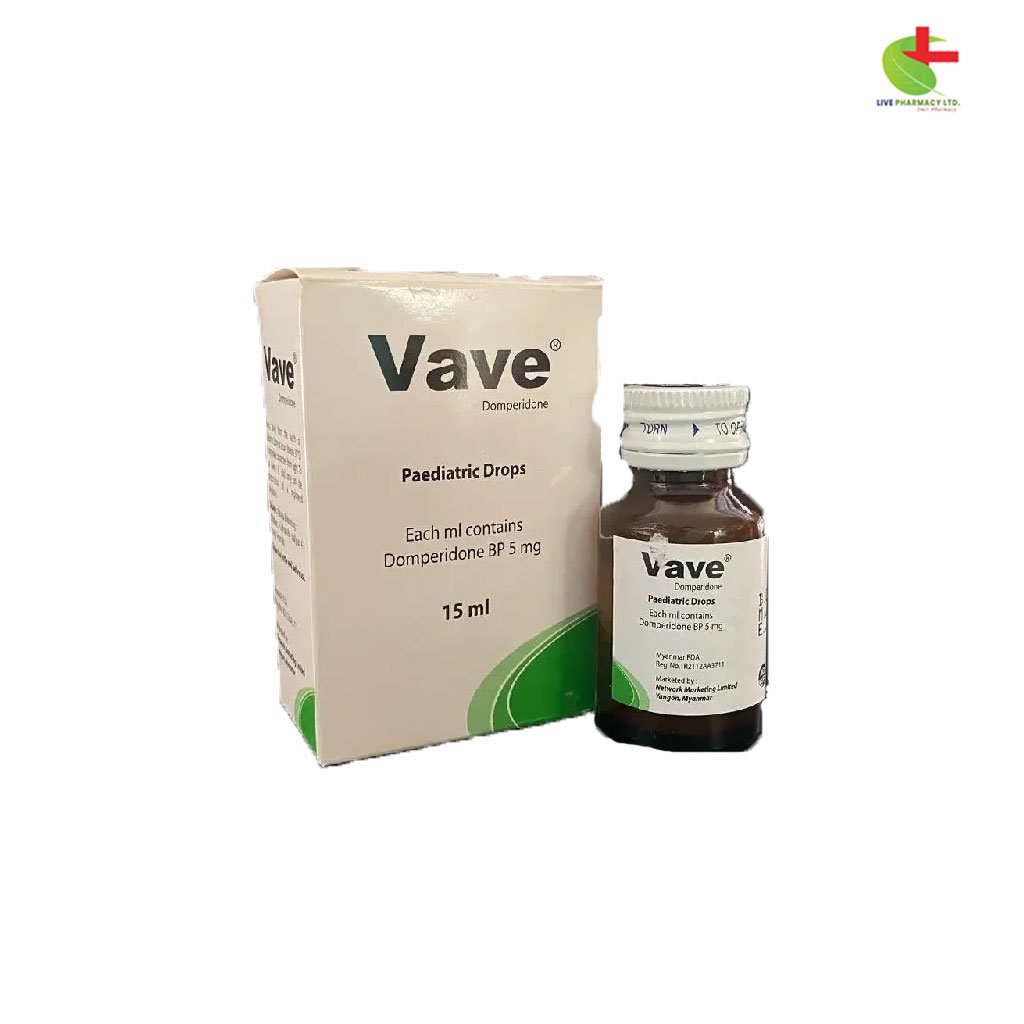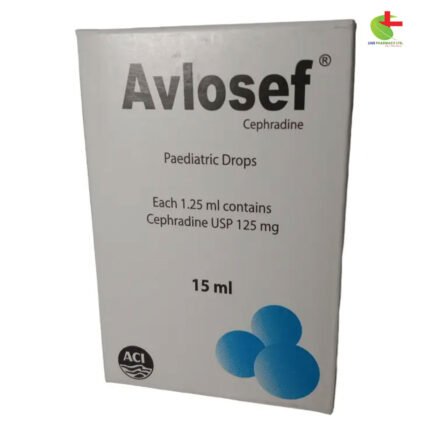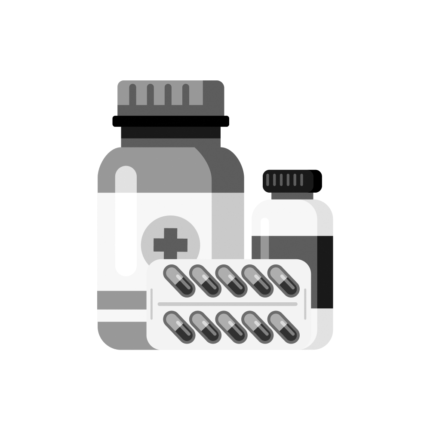Vave
25.08৳ Bottle (15ml)
- Vave is a medication containing Domperidone, used to treat dyspeptic symptoms, nausea, vomiting, and gastrointestinal motility disorders.
- It helps in conditions like delayed gastric emptying, heartburn, and nausea associated with Parkinson’s disease or migraine.
- Vave is also indicated for speeding up barium transit in radiological studies.
- It is available in tablets, suspension, and suppository forms, and should be taken as per a doctor’s recommendation.
 Brand
Brand
|
ACI Limited |
|---|---|
 Generics
Generics
|
Domperidone Maleate |
 Type
Type
|
Pediatric Drops |
Indications
Vave is primarily indicated for the following conditions:
- Dyspeptic Symptoms: Commonly associated with delayed gastric emptying, gastroesophageal reflux disease (GERD), and esophagitis, including:
- Epigastric fullness, abdominal distension, and upper abdominal discomfort
- Eructation, bloating, early satiety
- Nausea and vomiting
- Heartburn with or without regurgitation of gastric contents
- Non-ulcer dyspepsia
- Acute Nausea and Vomiting: Effective for nausea and vomiting arising from various causes, including functional, organic, infectious, dietary, radiotherapy, drug therapy, or migraines.
- Parkinson’s Disease: For controlling nausea and vomiting induced by dopamine agonists.
- Radiological Studies: Assists in speeding up barium transit during follow-through radiological imaging.
Consult a registered healthcare provider before using this medication.
Pharmacology
Vave contains Domperidone, a dopamine antagonist that works by blocking dopamine receptors in the Chemoreceptor Trigger Zone (CTZ) and the stomach. This action enhances gastrointestinal motility by restoring normal motility and tone of the upper gastrointestinal tract. Domperidone facilitates gastric emptying, stimulates antral and duodenal peristalsis, and regulates pyloric contraction. It also increases esophageal peristalsis and lowers esophageal sphincter pressure to prevent gastric reflux.
Domperidone’s minimal penetration of the blood-brain barrier ensures that it does not cause central nervous system effects, reducing the risk of psychotropic and neurological side effects.
Dosage & Administration
- General Instructions: Domperidone should be taken 15-30 minutes before meals or as advised by your healthcare provider.
- For Adults:
- 10-20 mg (1-2 tablets or 10-20 ml suspension) every 6-8 hours, with a maximum of 80 mg per day.
- For Children:
- 0.2-0.4 mg/kg body weight, every 6-8 hours, as either suspension or pediatric drops.
- For Dyspeptic Symptoms:
- Adults: 10-20 mg (1-2 tablets or 10-20 ml suspension) every 6-8 hours.
- Children: 0.2-0.4 mg/kg body weight every 6-8 hours.
- For Acute Nausea & Vomiting:
- Adults: 20 mg (2 tablets or 20 ml suspension) every 6-8 hours.
- Children: 0.2-0.4 mg/kg body weight, every 6-8 hours. (Max treatment duration for acute nausea and vomiting is 12 weeks).
- Rectal Use (Suppositories):
- Adults: 30-60 mg every 4-8 hours.
- Children (10-25 kg): Maximum daily dose of 30 mg, divided throughout the day. The treatment duration for suppositories is up to 12 weeks.
Always follow your healthcare provider’s instructions for correct dosage.
Drug Interactions
- Anticholinergics: May counteract Domperidone’s antidyspeptic effects.
- Antacids & Antisecretory Drugs: Should not be taken with Domperidone as they reduce its bioavailability.
- CYP3A4 Inhibitors: Drugs like azole antifungals, macrolide antibiotics, and HIV protease inhibitors can increase plasma levels of Domperidone.
- Drugs with Gastrokinetic Effects: Domperidone could potentially impact the absorption of drugs with sustained release or enteric coatings.
Domperidone may be safely used with:
- Neuroleptics: Does not potentiate their action.
- Dopaminergic Agonists: It helps suppress peripheral side effects (like nausea and digestive disturbances) without affecting central dopaminergic activity.
Contraindications
- Hypersensitivity: Contraindicated in patients allergic to Domperidone.
- Gastrointestinal Conditions: Not recommended for patients with gastrointestinal hemorrhage, mechanical obstructions, or perforation.
- Prolactinoma: Contraindicated in patients with pituitary tumors that release prolactin.
Side Effects
- Rare side effects include transient intestinal cramps and very occasional extrapyramidal symptoms in children, which generally reverse after discontinuation.
- Hyperprolactinemia: Rarely, Domperidone can increase prolactin levels, leading to galactorrhoea or gynaecomastia.
- Allergic Reactions: Skin rashes or urticaria may occur, though infrequently.
Pregnancy & Lactation
- Pregnancy: Domperidone has not shown teratogenic effects in animals. However, it should only be used in pregnancy if the benefits outweigh the risks, especially during the first trimester.
- Lactation: Domperidone is excreted in breast milk in lower concentrations compared to plasma levels. Its use is not recommended during breastfeeding unless the benefits justify the potential risks to the infant.
Precautions & Warnings
- Use in Children: Extra caution is required, as there is an increased risk of extrapyramidal reactions due to an immature blood-brain barrier.
- Liver Impairment: Use with caution in patients with liver dysfunction, as Domperidone is metabolized in the liver.
- Kidney Disorders: Domperidone may accumulate in patients with severe renal insufficiency, requiring dose adjustments.
Overdose Effects
Overdose symptoms may include drowsiness, confusion, and extrapyramidal reactions, especially in children. Treatment includes activated charcoal and supportive care. In cases of extrapyramidal effects, anticholinergic, antiparkinson, or antihistamine drugs may be useful.
Therapeutic Class
Motility Stimulants, Prokinetic Drugs, Dopamine Antagonists.
Storage Conditions
Store below 30°C, away from light and moisture. Keep out of reach of children.













Reviews
There are no reviews yet.